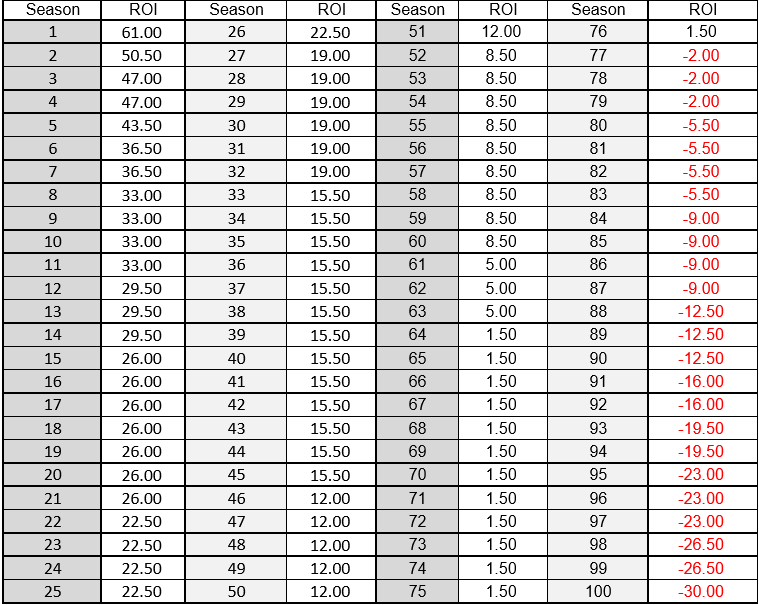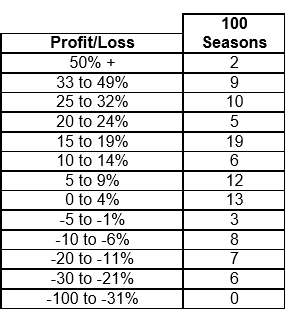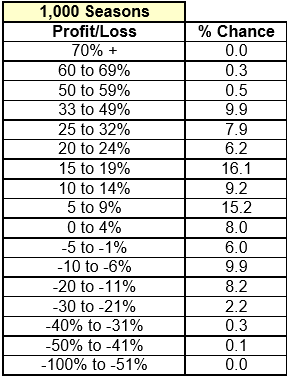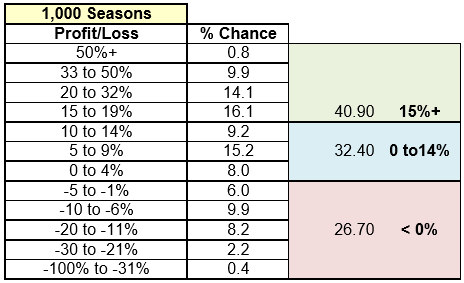
Our mental state when making betting decisions and investments is a main factor to follow our planned journey to long term profitability. The main reason punters deviate from strategy, comes from our topic of this article – variance.
Understanding how common bad, and good, stretches are in sports betting is of utmost importance for anyone who’s looking to take their game to a higher level. The cold hard truth is that we are looking for small edges, which means results will be having big swings, both up and down, even if our expected value of the bets are on the profitable side.
In this article we will cover what variance is, and how it works out, not only in theory, but practically. We will dive deeper into how this can affect our decision making, both good and bad, and eventually see how we can use this knowledge to our advantage.
As one of the least discussed topics in sports betting we hope to give you an advantage in your future betting ventures.
What is Variance?
To understand variance, we have to first have to understand Expected Value, or EV for short. You can read an in-depth explanation, with practical examples in our article – “What is Expected Value – A Complete Guide”. To make it as simple as possible, EV is a measurement of how much you can expect to win or lose on a placed bet over the long run.
EV is useful for punters to know if they are making long term profitable decisions, but this also comes with a drawback in form of variance. When placing bets we will never achieve true expected value, as there are random elements tied to each bet. While it will even out in the long run, we are victims to variance all the time, regardless.
An easy way to understand the concept is to imagine a coin toss, where everything is fair and even, meaning a 50% chance of either heads or tails. We have placed a bet of €100 on heads, for the great odds of 2.5. This bet would have an amazing expected profit of €75 each time the coin is tossed. If we imagine this bet being played 10 times, we can expect a profit, but it’s not guaranteed by any means.
We could theoretically be very unlucky and see tails come up 10 times in a row. This does not mean our bet was incorrect or not profitable – we were just a victim of negative variance. Don’t be mistaken though – even if we won 10 times in a row, we would have experienced variance, but on the positive side.
Long story short – variance is a way to measure how far something is from it’s expected value, meaning the average outcome. Value in our case being EV on our bets. To conclude this topic and move on to ways of utilizing the information to become a more profitable bettor, let’s take a look at an example of how variance works in practice.
Let’s imagine two different bets with vastly different profits and probabilities.
Bet #1
Outcome #1:
- Profit: -€100
- Probability: 50%
Outcome #2:
- Profit: €110
- Probability: 50%
Expected Value of our bet: €5
In this example we are betting on a very close game, where both teams are exactly even to win the game, but we have found an edge by one team being slightly undervalued, for the odds of 2.1. Logically, in case our team loses, we lose €100. In case of a win, we profit €110. Now, let’s move on to example #2, where we are instead betting on an underdog.
Bet #2
Outcome #1:
- Profit: -€100
- Probability: 80%
Outcome #2:
- Profit: €425
- Probability: 20%
Expected Value of our bet: €5
In this example we are betting on an underdog that has a 20% chance of winning, but they are undervalued and we have got a good price of 4.25. In this case, we will lose €100 every time our team loses, while we can rake in €425 every time they win.
Both of these bets have an expected return of €5, or 5% ROI. The difference of the bets can be found in their variance. The first bet will win 50% of the time, while the second one will only be successful 20% of the time. This means that the second bet has much more variance attached to it, as we will be losing much more often, but when we win, we win big. This will over the long run create big up- and downswings, that can heavily impact our bankroll and thus, our decisions.
You might have heard about standard deviation, which often gets mentioned when discussing variance. The examples above highlight the core of what it is, but we will spend some time making sure we understand the concept. Standard deviation has a direct relationship with how we can use the knowledge of what variance is, and how it impacts how successful our betting ventures become.
What is Standard Deviation?
Standard deviation is simply how big we can expect our variance to be, based on the volatility of our bets. From the examples above, the first example would have somewhat average standard deviation in betting terms, while the second example would have a very high standard deviation. To visualize how these different scenarios look and how they impact our long term results, we will use a so-called bell curve to our assistance.
I am not here to bore you with math equations and numbers, since for most purposes is not crucial to the topic we are trying to cover. This bell curve would represent our first example, which uses a quite average variance in its strategy. This means that our likelihood of being inside small margins of error after for example 1000 bets is high. If we increase our probability of winning the bets, by playing on smaller odds, we increase the confidence we will be winning over a short and shorter period.
With more bets added the confidence increases further, rapidly, hence why betting volume is very important. To realise close to true numbers we need to have a big sample size. Short periods of luck or bad luck, are essentially pointless to use as a metric of success in sports betting.
If we were to visualise the second example, with much higher volatility tied to it, the bell curve would essentially spike, and variance would dictate us to be far on the winning, or losing, side even with a big sample size. Controlling our variance is very important, as we want to reduce the risk by all means possible.
If we were to rely on low probability outcomes like the second example, even with great expected returns, we would need thousands upon thousands of bets to reach any kind of confidence in the results. Now, the good thing is that variance CAN be completely in our control, and we can adjust it as we wish on command.
How Can Variance be Controlled?
We have already learned a few things that impact the variance of our betting results, but lets list them all to start establishing a strategy to use it to our benefit. So, here are the variables changing how big or small our variance is:
- Expected value of our bets
- Probability of our bets winning
- Number of bets placed
To find practical ways to use each of these let’s break down each contributing factor and how we can view them in terms of how they impact our variance, and therefore, our decision making process.
Expected Value of Our Bets
It might be the most obvious thing on this list, but having a high EV on our bets is the key to success. Without an expected profit it doesn’t matter how you twist and turn it, you won’t be winning long-term.
Finding value comes down to having a good understanding of the sports, leagues and games you are betting on. To read more about this topic I recommend you read our article “Value Betting Explained”.
Probability of Our Bets Winning
If we take a step back and consider our example of this topic earlier, I hope the idea is clear – if we place bets on low probability outcomes, our variance will go up. High return and low risk is obviously what we are searching for, but sports betting is rarely that simple at the end of the day. When we get high odds it is also likely our variance goes up by the nature of it.
This does not mean we should stay away from high odds, IF they offer a very good expected return. To lower our variance we can intentionally stay away from the higher odds and focus on higher probability plays. In several sports we can also use markets that offer handicap betting, instead of playing on the straight lines. That way we can utilize the found value on a certain object, but lower the variance of the bet.
Variance equals risk, and as much as we want to reduce it, we also shouldn’t limit ourselves to the extent that we are missing out on great +EV bets. This balance is very important and our bankroll management, and betting strategy will be deciding factors in how we approach it.
Number of Bets Placed
Sample size is the most important factor to determine how accurate our results are, and how close they are to true numbers. Hundreds of bets might sound like a lot, but in the world of variance and sample size, it’s truly miniscule.
To give an example of how devastating variance can be, we will show an example of how likely a cold-streak is to happen over a certain number of bets. We will use a sample size of 1000 bets, with a 50% win probability.
Lose streak and its probability to occur
- 6 – 99.971%
- 7 – 98.148%
- 8 – 86.060%
- 9 – 62.388%
- 10 – 38.530%
- 11 – 21.539%
- 12 – 11.398%
- 13 – 5.862%
Just by looking at these numbers it becomes quite clear that cold-streaks, and thus, hot-streaks happen very frequently. Even long stretches are very likely to occur, and this is just with a relatively small sample size, all things considered.
As we have discussed before, these numbers would quickly escalate if we increase our variance even more, by betting on low probability outcomes. To cement the idea, let’s go through another example, but instead one where we are betting on 40% probability outcomes. It might not sound like an extreme change on the surface, but let’s have a look.
Lose streak and its probability to occur
- 6 – 99.999%
- 7 – 99.999%
- 8 – 99.913%
- 9 – 98.422%
- 10 – 91.434%
- 11 – 76.804%
- 12 – 58.153%
- 13 – 40.568%
As you can see, the increased variance in our betting selection has increased our likelihood of long stretches of losses by a lot. A 13 bet loss-streak has gone from 5.9% to 40.5% – quite amazing isn’t it? Even a 20 game loss-streak has a 1.4% of occuring over 1000 placed bets with these variables in place. These numbers grow exponentially as we increase our variance and sample size. Reducing variance might start sounding like a good idea right about now? If so – good.
To reduce our variance and unpredictability we need to increase our sample size, or simply how many bets we are placing. This should of course be done carefully, and while it’s good to diversify into new sports, leagues etc, that can be a difficult task. Or in the worst case scenario it could decrease our knowledge, where it previously was good. Again – a case of balance.
There is however an easy way to diversify and lower our variance without losing value on other fronts. Following other punters tips can be both fun and rewarding, granted you take the time to find the good ones. At Betting.com we have hundreds of bettors sharing their knowledge on a daily basis.
You can take part of their expertise and betting tips both for free and by paid subscriptions. All you need to do is head over to the betting tips section and start browsing. Besides the benefits of increasing your placed bets, you will also absorb new information to learn from, or even bolster the knowledge you already have.
By now it should be obvious that streaks of bad, or good, fortune is to be expected, and that we need to be armed to combat it. Our goal should always be to be profitable long-term, and as such cold-streaks will become a part of our betting life – it’s inevitable to happen.
The key lies in making informed, and logical decisions regardless. Now, I am not going to turn this into a sports betting psychology 101, but you can go ahead and read our 6 golden rules to the psychological side of betting, which will prepare you further to battle the tough times.
Using Bonuses & Offers
Before we move on, it should be highlighted that variance can also be lowered by other means than just the directly impactful ones. Bonuses and offers from bookmakers are a great example of this, as they simply give you more room for error.
There are many great welcome bonuses that will give you backup in case you hit a bad cold-streak, and this in turn lowers our overall variance. We simply add a cushion to what we already have. The same can be said for sports betting offers that range from free bets, to increased odds or money back on certain outcomes. All of this is a pure benefit, and with the amount of options for betting specifically, it’s something we should make use of every chance we get.
Betting Variance Simulations
To further understand the impact variance has on our sports betting results, we will now look at more simulations. This time not in the view of hot/cold streaks, but in form of a realistic betting period, and the overall effect.
For the purposes of our simulations, we will assume all bets are placed at odds of 3.50. Each bet will have a profit expectation of 10%. We will assume that we place 100 bets over the course of a football season.
So, what are the chances of having a winning or losing season based on placing 100 bets at odds of 3.50 with a profit expectation of 10%?
Based on simulations covering 100 seasons, the ROI returned in each season is shown below:

The best year out of the 100 showed a profit of 61%. The worst year out of 100 showed a loss of 30%.
We will condense the table into a slightly easier to follow format:

Despite placing every bet with a profit expectation of 10%, we are only likely to make money in three seasons out of every four. The best case scenario shows that in 26 of the 100 seasons we are likely to make 20% profit or more even though we only have a 10% edge.
We wanted to list the details from 100 individual seasons as we believe the table is a very powerful one. However, whilst 100 seasons may appear a long period of time, we want to get a more accurate picture. We will now extend the tests to 1,000 seasons:

Summary of Betting Variance Simulations
We will now put that information into a slightly easier to follow table:

- Around one season in ten will provide a profit of 33% or greater.
- Around four seasons in ten will make a profit of 15% or bigger.
- There’s a 50% chance the profits will be 10% or more.
- There’s around a one chance in four that we will make a loss.
- There’s a one chance in ten that the losses made will be in excess of 10%.
The chances of making a loss might be higher than you may have anticipated but this is fundamentally due to the relatively low number of bets per season. Had the number of bets been 200 per season, the loss chances would be lower.
- The figures show that a profit is likely to be made in 73 seasons out of 100.
These numbers show that even when betting with the odds in your favour, winning in the short-term is not inevitable. There is always a percentage chance that something good (winning) or bad (losing) will happen.
Even when winning is more likely to happen than losing, winning can never be taken for granted. This is why bankroll management is so important. The bankroll must take the strain when adverse periods strike.
To conclude this article, we will have a look at the dangers of knowing how variance works. It might sound silly, but they do exist.
The Dangers of Variance
Understanding variance when sports betting is crucial for success, but it does also come with a few drawbacks, or rather, a few pitfalls. This can be true both when winning and losing. Let’s take a look at the do-not’s of using variance when betting on sports.
When winning
When we are on a good run, and the wins are rolling in, we should never let ourselves become over confident in our ability. The cold hard truth is that it’s most often an illusion – due to positive variance. This often gets overlooked and instead we credit our own ability for being amazing bettors with infallible predictions.
I might sound like a party-pooper here, but it truly is important to be able to identify our hot-streaks as well. By doing so, we keep ourselves on our toes, and keep on researching and working the way we should be. It’s all too easy to loosen up and forget about the fundamentals we worked so hard for when things come too easy. I am not telling you not to enjoy the moment, and also take pride in the hard work behind the positive results. However, always keep in mind variance goes both ways. Overconfidence in the form of increasing bet sizing, betting without enough research, or any other pitfalls can get you destroyed real fast when the pendulum swings the other way around. Stick to your strategy, keep calm and work towards the end goal – long term profitability. Hard work pays off, keep it that way.
When losing
When we are facing a tough time, with results not going our way, it can be hard to keep a cool head. This is true for most people, but it’s a must to become a profitable bettor. Now, if we understand variance, this should be easier to accept. After all – it’s bound to happen right? Well, it is, but the danger lies in something else. It’s not unusual to hear punters talk about their cold-streaks and write it all down to variance. It might be true, but it also might not be.
It’s important to be able to recognize the two different scenarios for what they are. While being on a cold-streak it’s easy to blame variance for everything, even if the truth is that the bets were not profitable to begin with. Being honest towards yourself is key. The alarm bells should really be ringing if you see yourself betting on different sports, leagues, games, markets or whatever you are usually – take a step back and analyse if what you are doing actually is profitable or not.
At the end of the day the danger of variance, both when winning and losing, are solved by one thing, and one thing only – truly understanding that sports betting is a long journey, and the results over tens, or even hundreds of bets are not worth drawing final conclusions from. The mental game of betting is tough, but again, hard work and determination is what pays off.




